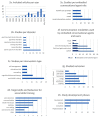Embodied Conversational Agents in Clinical Psychology: A Scoping Review
- PMID: 28487267
- PMCID: PMC5442350
- DOI: 10.2196/jmir.6553
Embodied Conversational Agents in Clinical Psychology: A Scoping Review
Abstract
Background: Embodied conversational agents (ECAs) are computer-generated characters that simulate key properties of human face-to-face conversation, such as verbal and nonverbal behavior. In Internet-based eHealth interventions, ECAs may be used for the delivery of automated human support factors.
Objective: We aim to provide an overview of the technological and clinical possibilities, as well as the evidence base for ECA applications in clinical psychology, to inform health professionals about the activity in this field of research.
Methods: Given the large variety of applied methodologies, types of applications, and scientific disciplines involved in ECA research, we conducted a systematic scoping review. Scoping reviews aim to map key concepts and types of evidence underlying an area of research, and answer less-specific questions than traditional systematic reviews. Systematic searches for ECA applications in the treatment of mood, anxiety, psychotic, autism spectrum, and substance use disorders were conducted in databases in the fields of psychology and computer science, as well as in interdisciplinary databases. Studies were included if they conveyed primary research findings on an ECA application that targeted one of the disorders. We mapped each study's background information, how the different disorders were addressed, how ECAs and users could interact with one another, methodological aspects, and the study's aims and outcomes.
Results: This study included N=54 publications (N=49 studies). More than half of the studies (n=26) focused on autism treatment, and ECAs were used most often for social skills training (n=23). Applications ranged from simple reinforcement of social behaviors through emotional expressions to sophisticated multimodal conversational systems. Most applications (n=43) were still in the development and piloting phase, that is, not yet ready for routine practice evaluation or application. Few studies conducted controlled research into clinical effects of ECAs, such as a reduction in symptom severity.
Conclusions: ECAs for mental disorders are emerging. State-of-the-art techniques, involving, for example, communication through natural language or nonverbal behavior, are increasingly being considered and adopted for psychotherapeutic interventions in ECA research with promising results. However, evidence on their clinical application remains scarce. At present, their value to clinical practice lies mostly in the experimental determination of critical human support factors. In the context of using ECAs as an adjunct to existing interventions with the aim of supporting users, important questions remain with regard to the personalization of ECAs' interaction with users, and the optimal timing and manner of providing support. To increase the evidence base with regard to Internet interventions, we propose an additional focus on low-tech ECA solutions that can be rapidly developed, tested, and applied in routine practice.
Keywords: clinical psychology; eHealth; embodied conversational agent; health behavior; human computer interaction; intelligent agent; mental disorders; review.
©Simon Provoost, Ho Ming Lau, Jeroen Ruwaard, Heleen Riper. Originally published in the Journal of Medical Internet Research (http://www.jmir.org), 09.05.2017.
Conflict of interest statement
Conflicts of Interest: None declared.
Figures



References
-
- Andrews G, Cuijpers P, Craske MG, McEvoy P, Titov N. Computer therapy for the anxiety and depressive disorders is effective, acceptable and practical health care: a meta-analysis. PLoS One. 2010;5(10):e13196. doi: 10.1371/journal.pone.0013196. http://dx.plos.org/10.1371/journal.pone.0013196 - DOI - DOI - PMC - PubMed
-
- Mohr DC, Cuijpers P, Lehman K. Supportive accountability: a model for providing human support to enhance adherence to eHealth interventions. J Med Internet Res. 2011;13(1):e30. doi: 10.2196/jmir.1602. http://dschool.stanford.edu/wp-content/uploads/2011/03/BootcampBootleg20... - DOI - PMC - PubMed
Publication types
MeSH terms
LinkOut - more resources
Full Text Sources
Other Literature Sources
Medical

